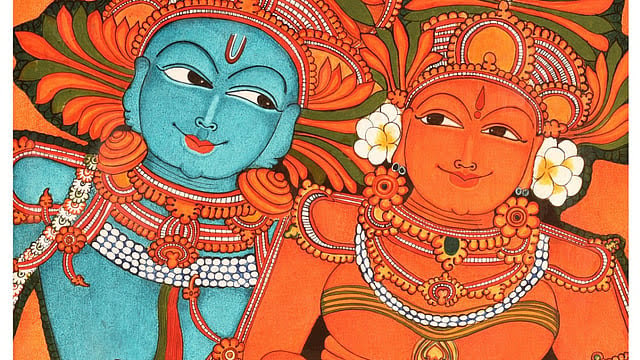How a Team of Women from Kerala Defied Dogma to Paint a Kozhikode Temple…
For centuries, the sacred walls of Kerala’s temples have been adorned with intricate murals, each stroke carrying not just artistry but also spiritual resonance. Traditionally, however, the task of creating these murals has been reserved for male artists trained in the rigorous discipline of temple art. But in Kozhikode, history was rewritten when a group of determined women picked up their brushes, defied long-standing taboos, and completed the vibrant mural painting of a local temple—an achievement hailed as both an artistic triumph and a cultural breakthrough.
The Breaking of Barriers
The temple, located on the outskirts of Kozhikode, had been undergoing a major restoration effort, including the repainting of its inner sanctum and surrounding walls. The temple authorities initially considered bringing in a traditional male mural team from Guruvayur, the cultural heart of Kerala’s mural art. But when a local women’s collective of artists, many trained at the Kerala Kalamandalam and other art institutes, came forward with a proposal, the idea sparked debate.
Painting temple walls, particularly in the sanctum precincts, has historically been seen as a sacred duty restricted to men. Critics argued that women’s involvement would violate ritual purity and disrupt tradition. Yet, the temple committee took the bold step of approving the women’s team, citing not only their artistic merit but also a responsibility to evolve with the times.
The Artists Behind the Revolution
The pioneering group was composed of 12 women, ranging in age from 24 to 52. Among them were graduates in fine arts, homemakers with a passion for painting, and even a former schoolteacher who had long dreamed of contributing to temple mural work. Their leader, 38-year-old artist Lakshmi Nair, described the moment as “a turning point not only for women in art but for Kerala’s cultural mindset.”
Armed with natural pigments, brushes crafted from bamboo, and the traditional discipline of Kerala mural painting—which demands precision, patience, and spiritual dedication—the team worked tirelessly for three months. They adorned the temple walls with vivid depictions of episodes from the Ramayana and Mahabharata, blending classical authenticity with subtle contemporary touches.
Tradition Meets Change
The project was not without hurdles. On the first day, some conservative voices staged a small protest outside the temple, holding placards warning against the “desecration” of sacred art by women. But as weeks went by, the protests dwindled, replaced by crowds of curious onlookers who admired the skill and devotion evident in the women’s work.
By the time the project concluded, the temple murals had become a local attraction. Pilgrims marveled at the brilliance of the colors and the finesse of the lines, many expressing surprise that the work had been carried out entirely by women. “We came here skeptical,” admitted one elderly devotee. “But after seeing their dedication, I can say the gods themselves would be pleased.”
A Ripple Effect Across Kerala
The Kozhikode temple mural project has sparked conversations across Kerala. Women artists from Thrissur, Palakkad, and even distant Kasaragod have reached out to the Kozhikode team, expressing interest in learning the techniques and participating in future temple projects. Art schools are also reporting a rise in female students eager to specialize in mural painting, inspired by the Kozhikode breakthrough.
Cultural scholars have noted that while women have long participated in Kerala’s folk arts—such as rangoli (kolam), weaving, and ritual singing—the leap into temple murals signals a deeper change. It represents not just gender inclusion but also the democratization of sacred art forms, once guarded tightly by caste and gender boundaries.
Official Recognition
Earlier this month, Kerala’s Department of Culture formally commended the Kozhikode women’s mural team, calling their work “a proud milestone in the state’s artistic journey.” Plans are underway to exhibit photographs of the murals at the Kerala Lalithakala Akademi, ensuring their story inspires beyond the temple walls.
A Message for the Future
Speaking at the mural’s inauguration, Lakshmi Nair summed up the team’s sentiment: “We did not come here to break tradition, but to continue it in our way. The gods we painted have no gender bias—they welcome devotion in every form.”
Her words resonated far beyond Kozhikode. What began as an experiment has now become a beacon of possibility, proving that when tradition embraces inclusivity, both art and faith are enriched.
The murals of Kozhikode will stand as more than just paintings. They are brushstrokes of defiance, devotion, and hope—a reminder that sometimes, the most sacred act is the courage to change.
Would you like me to also craft a 50-word headline/summary version of this story for quick publication, like in a newspaper front-page style?
